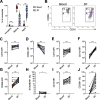Synovial fluid neutrophils in oligoarticular juvenile idiopathic arthritis have an altered phenotype and impaired effector functions
- PMID: 33836809
- PMCID: PMC8034063
- DOI: 10.1186/s13075-021-02483-1
Synovial fluid neutrophils in oligoarticular juvenile idiopathic arthritis have an altered phenotype and impaired effector functions
Abstract
Background: Neutrophils are the most prevalent immune cells in the synovial fluid in inflamed joints of children with oligoarticular juvenile idiopathic arthritis (JIA). Despite this, little is known about neutrophil function at the site of inflammation in JIA and how local neutrophils contribute to disease pathogenesis. This study aimed to characterize the phenotype and function of synovial fluid neutrophils in oligoarticular JIA.
Methods: Neutrophils obtained from paired blood and synovial fluid from patients with active oligoarticular JIA were investigated phenotypically (n = 17) and functionally (phagocytosis and oxidative burst, n = 13) by flow cytometry. In a subset of patients (n = 6), blood samples were also obtained during inactive disease at a follow-up visit. The presence of CD206-expressing neutrophils was investigated in synovial biopsies from four patients by immunofluorescence.
Results: Neutrophils in synovial fluid had an activated phenotype, characterized by increased CD66b and CD11b levels, and most neutrophils had a CD16hi CD62Llowaged phenotype. A large proportion of the synovial fluid neutrophils expressed CD206, a mannose receptor not commonly expressed by neutrophils but by monocytes, macrophages, and dendritic cells. CD206-expressing neutrophils were also found in synovial tissue biopsies. The synovial fluid neutrophil phenotype was not dependent on transmigration alone. Functionally, synovial fluid neutrophils had reduced phagocytic capacity and a trend towards impaired oxidative burst compared to blood neutrophils. In addition, the effector functions of the synovial fluid neutrophils correlated negatively with the proportion of CD206+ neutrophils.
Conclusions: Neutrophils in the inflamed joint in oligoarticular JIA were altered, both regarding phenotype and function. Neutrophils in the synovial fluid were activated, had an aged phenotype, had gained monocyte-like features, and had impaired phagocytic capacity. The impairment in phagocytosis and oxidative burst was associated with the phenotype shift. We speculate that these neutrophil alterations might play a role in the sustained joint inflammation seen in JIA.
Keywords: Juvenile idiopathic arthritis; Neutrophil; Oxidative burst; Phagocytosis; Phenotype; Reactive oxygen species; Synovial fluid.
Conflict of interest statement
The authors declare that they have no competing interests.
Figures





References
-
- Glerup M, Rypdal V, Arnstad ED, Ekelund M, Peltoniemi S, Aalto K, Rygg M, Toftedal P, Nielsen S, Fasth A, Berntson L, Nordal E, Herlin T, the Nordic Study Group of Pediatric Rheumatology Long-term outcomes in juvenile idiopathic arthritis: eighteen years of follow-up in the Population-Based Nordic Juvenile Idiopathic Arthritis Cohort. Arthritis Care Res (Hoboken) 2020;72(4):507–516. doi: 10.1002/acr.23853. - DOI - PubMed
Publication types
MeSH terms
LinkOut - more resources
Full Text Sources
Other Literature Sources
Medical
Research Materials

